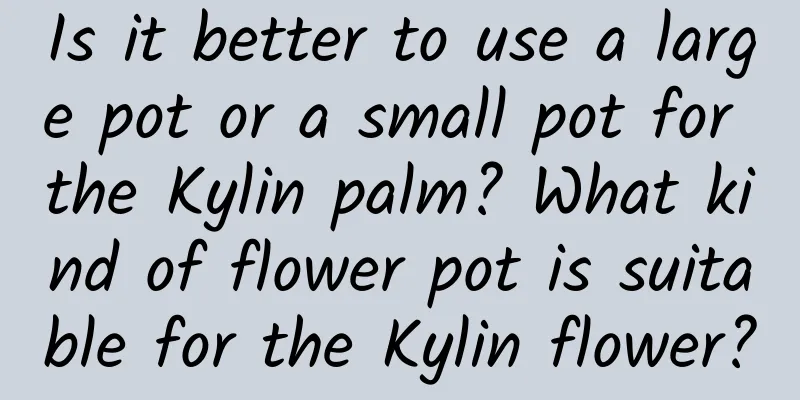Is it better to use a large pot or a small pot for the Kylin palm? What kind of flower pot is suitable for the Kylin flower?

|
Euphorbia is a kind of succulent plant, which belongs to the Euphorbiaceae family. The whole stem is very beautiful, and it grows in various shapes, which is more suitable for bonsai, so many people will choose to grow a pot. If the Euphorbia grows well, the whole plant will be very green and the brightness is very high. Selection of flower pots for EuphorbiaWhen planting Euphorbia pulcherrima, you should choose the flowerpot according to the size of the plant . If the plant is not very big, you don't need a flowerpot that is too big or too deep, otherwise it will easily accumulate water and rot the roots. If the plant is relatively large, you can use a larger flowerpot to plant it, and the choice of flowerpot is more flexible. The Euphorbia tridentata will grow relatively large and is suitable for planting in a taller and deeper pot . It grows vigorously and needs to be repotted once a year. In spring, when the Euphorbia tridentata begins to enter the growth period, it is the right time to repot. First, take out the plant, clean the old potting soil, slightly trim the roots, and then plant it in a larger and deeper pot. Time to repot the EuphorbiaIn spring, when the temperature rises, you can repot the Euphorbia pulcherrima between Qingming and Guyu . When repotting, remove the old soil, remove the old soil and rotten roots from the roots, keep the soil moist after repotting, place it indoors for about 10 days, and then gradually move it outdoors. How to repot the Euphorbia1. Repotting soil Before repotting the Euphorbia tridentata, you need to prepare suitable soil. It does not have particularly high requirements for the soil for its growth. It likes to grow in well-drained, loose and breathable soil . You can use leaf mold, garden soil, coal slag, etc. to evenly mix it. 2. Remove the original plant from the pot Remove the Euphorbia from the previous pot, being careful not to damage the root system . After removing the pot, trim off some tiny hairy roots, dry roots, and dead roots, disinfect it with disinfectant, and place it in a cool place to dry. Apply a proper amount of rooting powder before planting to help the roots adapt to the new pot. 3. Basin treatment When repotting, if you use bare roots, it is recommended to use moist soil , which is conducive to the full combination of roots and soil and the absorption of nutrients. Note that the soil should not be too wet to avoid root rot . If you use a soil ball for repotting, you can use dry soil , and water it appropriately after repotting to keep it moist. 4. Maintenance and management After repotting, you need to do a good job of maintenance and management. Avoid too much light in the early stage , and place it in a semi-shaded and ventilated environment for maintenance. When the plant adapts to the new pot and enters the acclimatization period, you can increase the light appropriately , and pay attention to regular watering to ensure that the pot soil is slightly moist . |
<<: Cutting methods and precautions for Jade Tree Cutting time and method for Jade Tree
>>: How to grow bone grass and precautions
Recommend
How to grow Daphne odora in winter
Winter maintenance methods Placement After the De...
Why is the Golden Diamond Flower called the King of Evil?
1. Why is it called this name? Its leaves are thi...
Hydroponic spiderwort protects Virgo
Hydroponic spiderwort Needless to say, hydroponic...
What are the cultivation methods and precautions of lipstick spider plant
Introduction of Lipstick Chlorophytum Lipstick sp...
How to prune and transplant green radish?
Pothos , a popular plant in the home, is known fo...
How to propagate hydrangea
How to propagate hydrangea: cutting propagation I...
Does Osmanthus fragrans prefer shade or sun?
Does Osmanthus fragrans prefer shade or sun? Swee...
Is hawthorn a fruit or a vegetable?
Is hawthorn a fruit or a vegetable? Hawthorn is a...
High-yield cultivation technology of loofah
Luffa is not only edible as a vegetable , but als...
Can potassium permanganate solution be used to water flowers directly? What is its effect?
Potassium permanganate direct watering Potassium ...
Difference Between Canna and Bird of Paradise
1. Morphological characteristics 1. Canna. Its pl...
How do Margarite flowers survive the winter?
1. Soil It is actually very obvious what environm...
When is the best time to transplant climbing roses?
When transplanting climbing roses, it is best to ...
Pecan planting conditions Climate and environment of the planting area
Pecan Planting Conditions Pecan is a semi-sun pla...
The efficacy and function of psyllium
1. Diuretic Plantago seed has the effect of diure...









